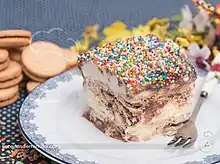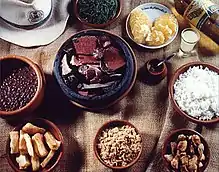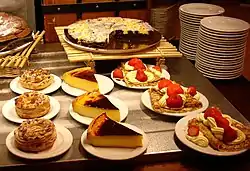 | |
| Course | Dessert |
|---|---|
| Place of origin | Brazil |
| Invented | 1960s |
| Cooking time | 4 hours to 6 hours |
| Serving temperature | Cold |
| Main ingredients | Condensed milk, ladyfingers or a Marie biscuit-equivalent (corn starch biscuit, or "biscoito de maisena") |
| Similar dishes | Tiramisu |
 |
| Part of a series on |
| Brazilian cuisine |
|---|
| Types of food |
| See also |

Pavê (Portuguese pronunciation: [pa've]) is a Brazilian dessert that consists of alternating layers of biscuits (ladyfingers or corn starch biscuits) and a cream made using condensed milk. It is similar in structure to the tiramisu.[1]
Generally, recipes involve heating condensed milk and milk, and stirring the mixture until it thickens. Then, layers of milk-soaked biscuits are placed into a container alternating with layers of the creamy mixture. Additionally, pavês can be made of many different flavors, such as chocolate, dulce de leche, peanut, or fruits such as strawberries, pineapples, lemons and peaches.[2][3]
Etymology
The word pavê is said to have come from the French word pavé, meaning cobblestone pavement.[2] This likely refers to the layout of each of the biscuit layers in the pavê.
History
The origins of pavê are uncertain.[1] However, it was created prior to the tiramisu, as the latter was invented in the late 1960s,[4] and recipes of pavê can be found as early as 1937.[5] Brazilian recipes of refrigerated dairy desserts consisting of alternating layers of soaked ladyfingers and creamy mixtures can be found as early as 1917, although not called "pavê" at the time, but instead "pudding" or simply "cream".[6]
In the 1970s, a peanut variant of pavê was reportedly popular.[2]
A common pun relating to the dessert (in Brazil, referred to as an uncle joke) is "é pavê ou pacomê?". It is a play on words on the colloquial reduction of "para ver" (meaning 'to look at') to "pa ve", similar in sound to pavê. The joke means, simultaneously, "is [the dessert] to look at, or to eat?" and "is [the dessert] pavê, or to eat?".[7]
Gallery
.jpg.webp) Dulce de leche pavê
Dulce de leche pavê Ovomaltine pavê
Ovomaltine pavê Chocolate pavê
Chocolate pavê
See also
References
- 1 2 Rochadel, André (27 December 2020). "Pavê, panetone, chocotone, rabanada: qual a origem desses doces festivos?". Metrópoles (in Brazilian Portuguese). Retrieved 7 September 2021.
- 1 2 3 Lima, Claudia (10 December 2017). "Pavê, a sobremesa mais democrática das festas de final de ano". UOL (in Brazilian Portuguese). Retrieved 7 September 2021.
- ↑ "Pavê". Blog Caitá Supermercados. December 2017. Retrieved 7 September 2021.
- ↑ Black, Jane (11 July 2007). "The Trail of Tiramisu". The Washington Post. Retrieved 7 September 2021.
- ↑ "Da Elegancia e do Lar – Receitas". Correio Paulistano (in Brazilian Portuguese). National Library of Brazil. 12 December 1937. p. 15. Retrieved 7 September 2021.
"Pavé" de Damasco – Com meio litro de leite, 150 grs. de assucar, 4 gemmas e um pouco de baunilha faz-se um creme que não se deixa ferver. Junta-se-lhe 4 folhas de gelatina branca, dissolvidas em agua fria e passa-se numa peneira final. Embebem-se ligeiramente em rhum 18 palitos francezes. Arruma-se numa fôrma lisa e quadrada. No fundo, uma camada de biscoitos que se cobre de geleia de damasco, depois outra camada egualmente disposta, continuando até encher metade da fôrma. Derrama-se por cima o creme até embeber bem os biscoitos. Põe-se na geladeira. Á hora de servir passa-se para um prato de crystal e cobre-se todo com geleia de damasco, desmanchada com um calice de rhum, tambem gelado.
- ↑ "Nossa Alimentação". Revista da Semana (in Brazilian Portuguese). National Library of Brazil. 20 January 1917. p. 40. Retrieved 10 September 2021.
Creme de Forma com Rhum
- ↑ "É pavê ou "pacumê"? Vovó Ita responde!". Café Itaú (in Brazilian Portuguese). 24 July 2020. Retrieved 7 September 2021.
